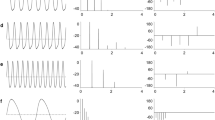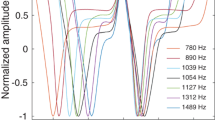Summary
Three species of Gymnotid fish, two species ofHypopomus andRhamphichthys rostratus, each having “pulse” type electric organ discharges (EOD) of different durations were studied to learn if any correlation exists between the spectral composition of the species specific EOD pulse and the frequency response characteristics of that species' electroreceptors. The receptor population consisted of two major categories (examples in Fig. 3). One category, termed pulse marker receptors, responded to suprathreshold stimulus pulses with a single spike at a short (<2 ms) latency. These receptors were tuned to the higher frequency components of a species' EOD (Fig. 4A) and were always 5 to 10 dB less sensitive than any other electroreceptors within a given species. The second major receptor category, burst duration coders, responded to an electrical stimulus with a burst of spikes at a longer latency, burst length was a function of stimulus amplitude. This second category could be further divided into three sub-categories according to the receptors' frequency response characteristics. The most commonly seen subcategory, wide band receptors (Fig. 4B), responded best to stimuli having frequencies equal to the dominant frequency component of the species' EOD in the two species ofHypopomus studied. A second subcategory, narrow band receptors (Fig. 4 A), had frequency response characteristics similar to those of the pulse marker receptors; however, these had thresholds 10 dB lower than those of the pulse marker. The third subcategory of burst duration coders, low frequency receptors (Fig. 4 C, D), responded best to stimulus frequencies ranging from about 50 to 150 Hz. Mechanisms of coding stimulus amplitude and responses to prolonged sinusoidal electrical stimuli were also studied in the various receptor types.
It is suggested that the differences in the major receptor types and the different frequency response characteristics of the electroreceptors within a given species allows the animals to identify and evaluate signals resulting from their own EOD, the EODs of conspecifics and electrical stimuli generated by other species of electric fish.
Similar content being viewed by others
References
Bastian, J.: Receptive fields of cerebellar cells receiving exteroceptive input in a Gymnotid fish. J. Neurophysiol.38, 285–300 (1975)
Bennett, M.V.L., Steinbach, A.B.: Influence of electric organ control system on electrosensory afferent pathways in Mormyrids. In: Neurobiology of cerebellar evolution and development (R. Llinas ed.), pp. 207–214. Chicago: American Medical Association 1969
Bullock, T.H.: Representation of information in neurons and sites for molecular participation. Proc. nat. Acad. Sci. (Wash.)60, 1058–1068 (1968)
Bullock, T.H.: An essay on the discovery of sensory receptors and the assignment of their functions together with an introduction to electroreceptors. In: Electroreceptors and other specialized receptors in lower vertebrates. Handbook of sensory physiology, Vol. III/3 (A. Fessard, ed.), pp. 1–12. Berlin-Heidelberg-New York: Springer 1974
Fessard, A., Szabo, T.: Physiology of electroreceptors. In: Handbook of sensory physiology, Vol. III/3 (A. Fessard, ed.), pp. 59–124. Berlin-Heidelberg-New York: Springer 1974
Hagiwara, S. Kusano, K. Negishi, K.: Physiological properties of electroreceptors of some Gymnotids. J. Neurophysiol.25, 430–449 (1962)
Heiligenberg, W.: Electrolocation of objects in the electric fishEigenmannia (Rhamphichthyidae, Gymnotoidei). J. comp. Physiol.87, 137–164 (1973)
Heiligenberg, W.: Electrolocation and jamming avoidance in aHypopygus (Rhamphichthyidae, Gymnotoidei), an electric fish with pulse-type discharge. J. comp. Physiol.91, 223–240 (1974)
Heiligenberg, W.: Electrolocation and jamming avoidance in the Mormyrid fishBrienomyrus. J. comp. Physiol.109, 357–372 (1976)
Hopkins, C.D.: Stimulus filtering and electroreception: Tuberous electroreceptors in three species of Gymnotid fish. J. comp. Physiol., in Press (1976)
Kalmijn, A.J.: The detection of electric fields from inanimate and animate sources other than electric organs. In: Electroreceptors and other specialized receptors in lower vertebrates. Handbook of sensory physiology, Vol. III/3 (A. Fessard, ed.), pp. 147–200. Berlin-Heidelberg-New York: Springer 1974
Scheich, H., Bullock, T.H.: The detection of electric fields from electric organs. In: Electroreceptors and other specialized receptors of lower vertebrates. Handbook of sensory physiology Vol. III/3 (A. Fessard ed.), pp. 201–256. Berlin-Heidelberg-New York: Springer 1974
Suga, N.: Electrosensitivity of specialized and ordinary lateral line organs of the electric fishGymnotus carapo. In: Lateral line detectors (P. Cahn, ed.), pp. 395–409. Indiana University Press 1967
Szabo, T.: Anatomy of the specialized lateral line organs of electroreception. In: Electroreceptors and other specialized receptors in lower vertebrates. Handbook of sensory physiology, Vol. III/3 (A. Fessard, ed.), pp. 59–124. Berlin-Heidelberg-New York: Springer 1974
Author information
Authors and Affiliations
Additional information
Supported by NIH Grant #1 RO1 NS 12337-01
Rights and permissions
About this article
Cite this article
Bastian, J. Frequency response characteristics of electroreceptors in weakly electric fish (Gymnotoidei) with a pulse discharge. J. Comp. Physiol. 112, 165–180 (1976). https://doi.org/10.1007/BF00606536
Received:
Issue Date:
DOI: https://doi.org/10.1007/BF00606536




